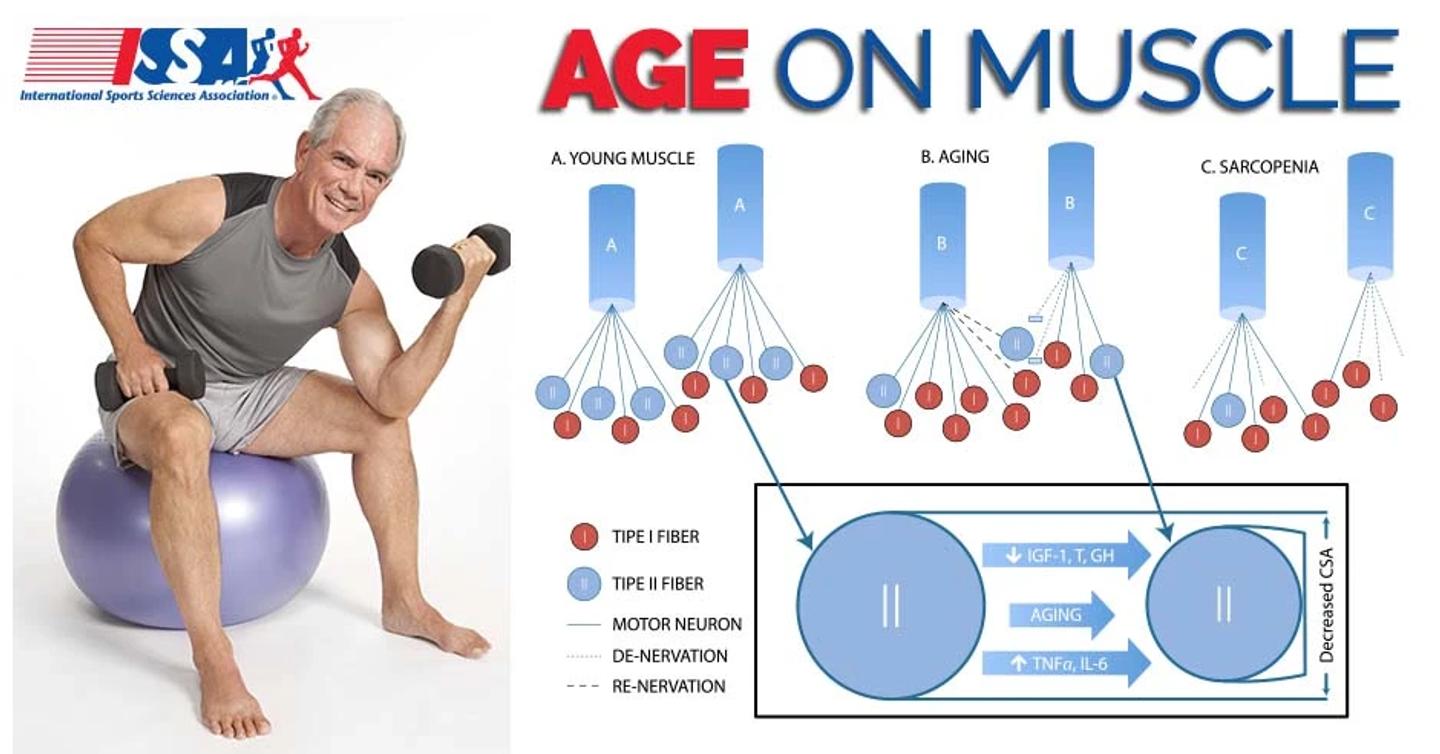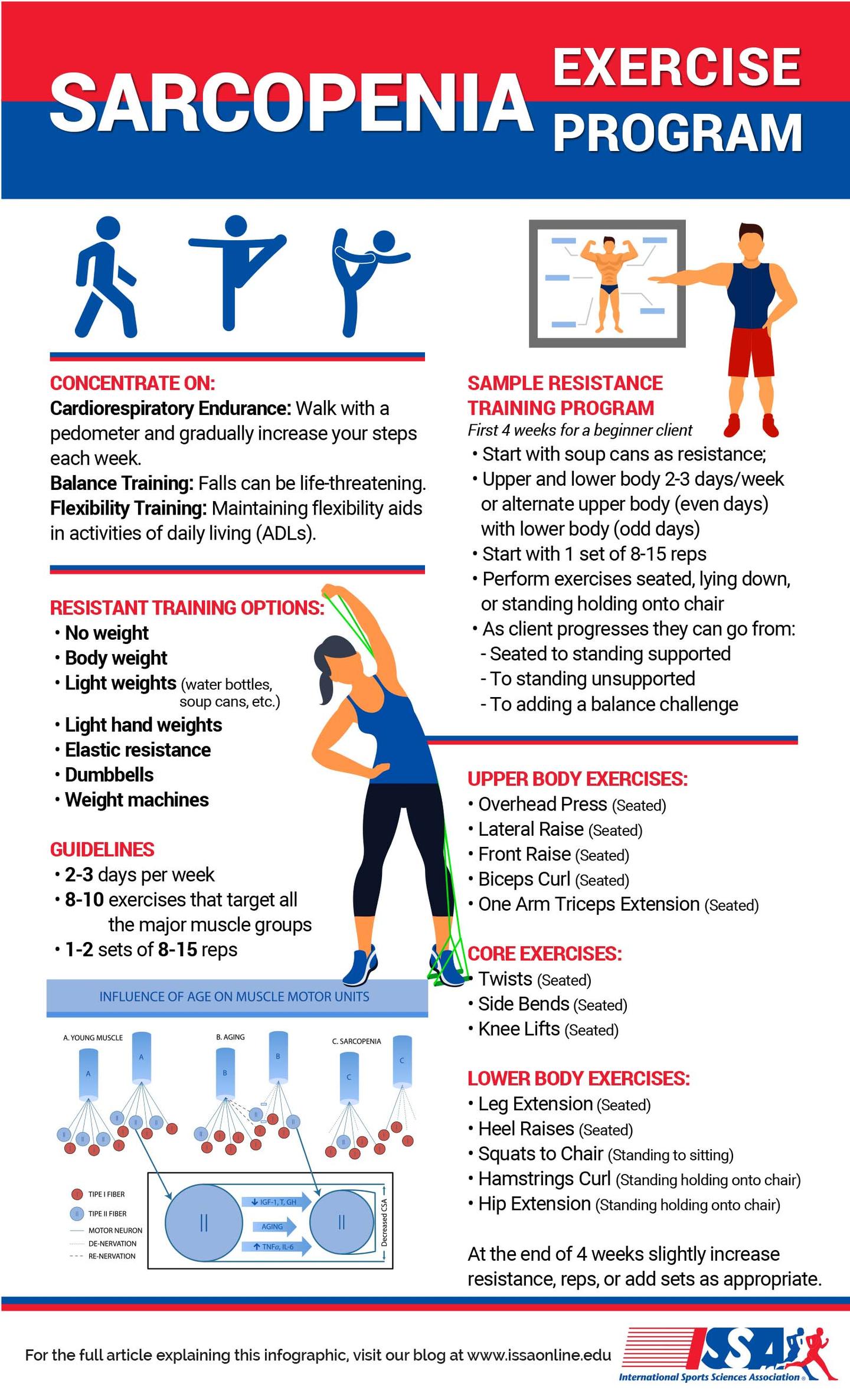
Fighting Sarcopenia with Exercise and Nutrition
Reading Time: 4 minutes
BY: Jane Curth
DATE: 2022-04-01
Growing old is an idea that we often push away in our minds until we find ourselves staring in the mirror at an aging self.
Perhaps we don’t like to think about the future because of the media conveying it in a negative way (needing medication, memory loss, sedentary, etc.).
With aging comes more medical concerns, such as osteoporosis, arthritis, dementia and a whole host of others. Another threat is Sarcopenia, and we’re going to talk about what it is, how it develops in the body, how to manage it, how to prevent it, and most importantly how to use exercise and nutrition to treat it.
What is Sarcopenia?
Sarcopenia is a disease of the muscles in which muscle mass decreases over time, especially after age 50.1 Sarcopenia isn’t caused by any single factor, but the development of it can be attributed to lifestyle factors. Adults suffering from this condition can end up losing over half of their muscle mass by the time they’re 80. Although sarcopenia is bad enough by itself, elderly adults often have other additional problems which can make for a debilitating mix of illnesses their lifestyle.
What Causes Sarcopenia?
There are several factors contributing to the disorder such as sedentary lifestyle, lack of exercise, and poor nutrition. Also, a reduction of neuromuscular junctions, declining hormone production, and several inflammatory conditions within the body all contribute to the condition.2
For most able-bodied adults, the body’s decline into full-blown Sarcopenia can be slightly mitigated, if not outright managed, with the right exercise and nutrition. The only pharmaceutical intervention currently accepted to help treat the condition is steroids, but that’s not even a total treatment. So, what’s the best way to manage Sarcopenia?
The Role of Exercise
Exercise and proper nutrition help battle this disease. A study by the NIH reports that “resistance training is a highly effective strategy to offset sarcopenia and it has numerous beneficial ‘spillover’ effects...obvious increases in muscle mass, strength, and functional performance in older individuals.”1 These benefits are exactly what the doctor ordered for positive outcomes.
This can also help prevent secondary problems from osteoporosis and arthritis, making exercise the ideal solution for other issues facing aging populations.
However, this does NOT mean that those with the condition must lift heavy loads. Simply offering resistance from bands or light weights is sufficient for optimal outcomes. Inexperienced and infirm clients will place themselves at much greater risk when lifting heavy. So keep resistance at intensities the individual can properly control.
A steady and light cardio regimen can also help muscle function and heart health, but the key with Sarcopenia is resistance training.
Click image to view full infographic or download PDF and print for your clients.

Proper Diet and Supplements Help
Research has also shown that taking a protein supplement in conjunction with resistance training resulted in higher lean body mass compared with the control and resistance training alone group1
According to Today’s Dietician, there are three main objectives when putting together a nutritional plan.3 For one, protein must be a staple. This can come from sources like cheeses, beans, legumes, and Greek yogurt. Additionally, adding powdered milk to soups is another great way to sneak in some extra protein for elderly people who might have trouble chewing solid foods. Second is vitamin D. Adding a vitamin D supplement will help support bone and muscle health. Finally, it’s essential that the individual eats enough calories to prevent weight loss, especially in muscle mass.
Prevention
Since Sarcopenia isn’t directly attributed to any single factor, there’s no guarantee that a person will be able to prevent it. But that doesn’t mean all is lost! As with most diseases, an ounce of prevention is worth a pound of cure.
Being active is a huge component of success here. The earlier a person gets into the habit of exercising, the better off they’ll be. It’s about doing things like resistance training, being active, and getting sufficient nutrients that will play the biggest role in preventing Sarcopenia.
Training Clients with Sarcopenia
The main concern for clients with Sarcopenia is safety. Remember with this population, even small injuries can be life-changing. Do not push them beyond their limits.
Make sure you start off with programs being incredibly simple and only slowly add intensity at a snail’s pace. This is a great opportunity for fitness professionals to reach people who have a desperate need for their services. All around, it’s a great situation to make a positive impact on a population that really will benefit from it.
REFERENCES
Phillips, S. M. “Nutritional Supplements in Support of Resistance Exercise to Counter Age-Related Sarcopenia.” Advances in Nutrition: An International Review Journal, vol. 6, no. 4, Jan. 2015, pp. 452–460., doi:10.3945/an.115.008367.
Walston, Jeremy D. “Sarcopenia in Older Adults.” Current Opinion in Rheumatology, vol. 24, no. 6, 2012, pp. 623–627., doi:10.1097/bor.0b013e328358d59b.
Dorner, Becky, and Mary Ellen Posthauer. “Nutrition's Role in Sarcopenia Prevention.” Today's Dietitian, Sept. 2012, www.todaysdietitian.com/newarchives/090112p62.shtml.
RELATED ARTICLES
Exercise Improves Symptoms for Those with Fibromyalgia
The causes of fibromyalgia are not fully understood and so there is no cure. However, that doesn’t mean there aren’t steps to improve health, fitness, mood, and symptoms of those living with this condition. Exercise is just one lifestyle change that can greatly increase the quality of life for those with fibromyalgia.
Dealing with Epilepsy as a Fitness Professional
Hear the personal and inspiring story of ISSA certified trainer, Dominic Frazier, who has accomplished so much in sports and fitness while battling a serious, chronic illness. His story helps inspire others to use fitness to overcome challenges.
People with Seizures Can Train: Here’s How to Do it Safely
Getting fit at the gym and working with a trainer should not be limited to people who have no health issues. Everyone can work out and should work out, right? What about people who are prone to having seizures. These can be dangerous, especially in a crowded gym full of people and equipment. As trainers, we accommodate all of our clients’ special needs. Here’s how to work safely with an epileptic client.
Featured Course
ISSA | Senior Fitness Instructor
Specialize in a group of clients that have the time, money and motivation to work with a Certified Personal Trainer. By the year 2030, the number of Americans over the age of 65 will grow to over 63 million. This group now constitutes the fastest growing segment of our population.